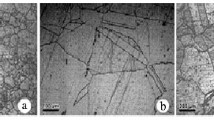Conclusions
-
1.
It has been observed that the fatigue crack growth macrorate dl/dN in Cu−7.5% Al is related to the depth of the microscopic plastic zone h by an exponential relationship of the form
$$\frac{{dl}}{{dN}} = Bh^p $$where B and p are constants in a certain range of zone depth dependent upon medium. The critical zone depth hcr corresponding to the break on the crack growth rate curve is 2.5–3 grain diameters in both media.
-
2.
In the initial period of crack growth, when the depth of the plastic zone has not reached hcr, the microrate exceeds the macrorate, i.e., a striation is formed not in each load cycle but in the last of a series of cycles. This is characteristic of a fatigue crack in both media but in vacuum the differences between micro- and macrorates are greater than in air. When the plastic zone exceeds the value of hcr the macrorate becomes equal to the microrate, i.e., a striation occurs in each load cycle.
-
3.
Fatigue crack growth in Cu−7.5% Al alloy in vacuum occurs by the formation of striations which are just as clear and regular as in air. In AMg6 alloy distinct striations appear in vacuum only at low temperature. This confirms the fact that the formation of fatigue striations is not the result of action of the air medium.
-
4.
A hypothesis is stated that the formation of striations in fatigue crack growth occurs with a limited plastic zone size and is dependent upon the mechanism of their formation during relaxation of stresses requiring a certain degree of elastic restraint of plastically deformed microvolumes.
Similar content being viewed by others
Literature cited
F. J. Bradshaw and C. Wheeler, “The effect of environment on fatigue crack growth in aluminum and some aluminum alloys,” in: Applied Materials Research (April, 1966), pp. 112–119.
R. J. Sherman and M. R. Achter, “Crack propagation in air and vacuum for nickel and nickel-chromium-aluminum alloys,” TMS AIME,224, No. 1, 144–147 (1962).
R. P. Wei, “Some aspects of acceleration of fatigue crack growth under environment action,” Eng. Fract. Mech.,1, No. 4, 633–651 (1970).
N. M. Grinberg, V. A. Serdyuk, S. G. Zmeevets, and I. L. Ostapenko, “The growth of fatigue cracks in MA12 magnesium alloy in air and in vacuum,” Probl. Prochn., No. 3, 12–16 (1978).
A. Ohta and E. Sasaki, “The plastic zone around fatigue cracks of pure iron in vacuum and dry air,” Acta Metall.,20, No. 5, 657–660 (1972).
E. N. Aleksenko and N. M. Grinberg, “The influence of vacuum on the plastic zone near a fatigue crack in Armco iron,” Probl. Prochn., No. 10, 101–104 (1979).
B. Bouchet and J. de Fouquet, “Relation entre l'etendue de la zone plastique et la propagation des fissures de fatigue in influence de l'environment,” in: 4th Int. Conf. on the Strength of Metals and Alloys, Nancy (1976), pp. 485–489.
N. M. Grinberg, V. A. Serdyuk, and S. G. Zmeevets, “The influence of the structural state on the fatigue failure of MA12 magnesium alloy in air and in vacuum. Report 3. The influence of a vacuum medium on fatigue crack growth,” Probl. Prochn., No. 11, 95–100 (1978).
N. M. Grinberg, I. L. Ostapenko, and E. N. Aleksenko, “The fractography of fatigue failure of silicon iron in a wide range of deformation amplitudes,” Probl. Prochn., No. 7, 33–38 (1979).
D. A. Meyn, “Comparison between air and vacuum fatigue fracture in 7A1-2Nb-1Ta titanium alloy,” U.S. Naval Res. Lab. Rep. NRL Progr., No. 5, 20–21 (1966).
D. L. Ritter and R. P. Wei, “Fractographic observations of Ti-6A1-4V alloy fatigued in vacuum,” Met. Trans.,2, No. 11, 3229–3230 (1971).
N. M. Grinberg, E. N. Aleksenko, and I. L. Ostapenko, “The kinetics of fatigue crack growth in silicon iron in vacuum and air media,” Probl. Prochn., No. 11, 39–44 (1977).
C. E. Feltner and C. Laird, “Factors influencing the dislocation structures in fatigued metals,” Trans. Met. Soc. AIME,242, No. 7, 1253–1257 (1968).
N. M. Grinberg, V. A. Serdyuk, L. F. Yakovenko, et al., “The kinetics and mechanism of fatigue failure of MA2-1 and MA12 magnesium alloys,” Probl. Prochn., No. 8, 40–45 (1977).
V. A. Serdyuk, “An investigation of fatigue crack growth rate in magnesium alloys at room and low temperatures,” Probl. Prochn., No. 11, 18–23 (1980).
P. J. Cain, R. Plankett, and T. E. Hutchinson, “Fatigue crack propagation rates for duralumin in simple bending,” Trans. ASME, Ser. D, J. Basic Eng., No. 2, 88–96 (1975).
G. Birkbeck, A. E. Incle, and G. W. J. Waldron, “Aspects of stage II fatigue crack propagation in low carbon steel,” J. Mater. Sci.,6, No. 6, 319–323 (1971).
N. M. Grinberg, V. A. Serdyuk, and S. G. Zmeevets, “The influence of the structural state on the fatigue failure of MA12 magnesium alloy in air and in vacuum. Report 2. Macroscopic and microscopic features of crack growth in air,” Probl. Prochn., No. 10, 46–52 (1978).
W. J. Plumbridge and D. A. Ryder, “The influence of specimen geometry on the mode of fatigue crack growth in aluminum,” Acta. Met.,17, No. 12, 1449–1452 (1969).
C. Laird and C. G. Smith, “Initial stages of damage in high stress fatigue in some pure metals,” Phil. Mag.,8, 1945–1963 (1963).
D. H. Andreasen and F. H. Vitavec, “The effect of temperature on fatigue crack propagation in linepipe steel,” Met. Trans.,5, No. 8, 1779–1783 (1975).
Author information
Authors and Affiliations
Additional information
Translated from Problemy Prochnosti, No. 4, pp. 20–25, April, 1981.
Rights and permissions
About this article
Cite this article
Grinberg, N.M., Gavrilyako, A.M., D'yakonenko, N.L. et al. Fatigue crack growth and the plastic zone in air and in vacuum. Strength Mater 13, 420–425 (1981). https://doi.org/10.1007/BF00762492
Received:
Issue Date:
DOI: https://doi.org/10.1007/BF00762492




